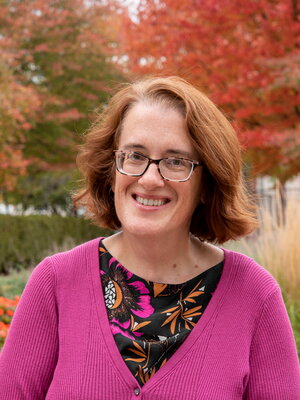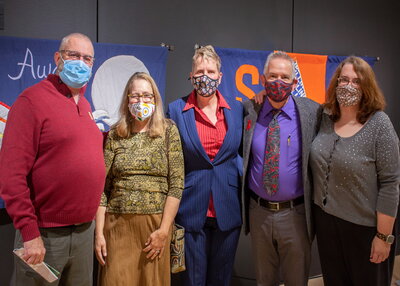
Meet Beth Watkins (BA, '96, history; MS, '02, information science), the manager of exhibit interpretation and visitor experience at Spurlock Museum at the University of Illinois Urbana-Champaign. She's been working in museums since 1994 and has been at Spurlock since she joined as a graduate assistant while completing a master's in information science at the iSchool in 2000. She also has a master's degree in museum studies from the University of Toronto. She credits her history degree with teaching her to follow her curiosity and seek answers, and for sharpening her writing and communications skills. Her proudest achievement is collaborating with history professor Kathryn Oberdeck and students from the History Harvest class, Jerry Carden (co-founder of the Greater Community AIDS Projects of East Central), Illinois Public Media, and journalism students on the Sewn in Memory: AIDS Quilt Panels from Central Illinois exhibit. Read on for a Q&A to learn more about her career.
Why did you decide to pursue a degree in history?
I entered the U of I without a declared major. I grew up in a small town, and I was excited to be at a huge university where I could explore any subject I could think of. I spent my freshman year taking gen eds in areas that I hadn’t had the opportunity to try in high school: anthropology, East Asian religions, unusual topics in Campus Honors Program seminars. But both of my parents were history professors at another Illinois university, so no one was surprised when I decided to major in history too. In my sophomore year, I stumbled into volunteering at the university’s Museum of Natural History (now closed) and quickly realized that museums were what I wanted to do with my career. I wasn’t specific about what kind of museum at that time, but I was confident that history would be relevant training, even if I didn’t intend to use much of the actual content. And I was right!
Did you pursue higher education after undergrad?
Right out of undergrad, I went to the University of Toronto to do a master’s of museum studies. Two years later, I came back to the U of I for a master’s in information science at the iSchool (GSLIS at the time).
What was your first job after college?
I kept my college job working at the Museum of Natural History for a few months after I graduated. In grad school in Canada, I didn’t have a work visa, so I could only do unpaid internships. When I came back, I was an office assistant in a law firm while I looked for museum jobs. My first museum job after my master’s was as an education intern at the Lake County Museum in Wauconda (now called the Dunn Museum in Libertyville).
What is your current career and how does your degree in history inform your work?
Apart from my brief excursion into legal paperwork, I have been working in museums since 1994! I’m currently the Manager of Exhibit Interpretation and Visitor Experience at the Spurlock Museum at the U of I. I’ve actually been at Spurlock since 2000, when I joined as a graduate assistant during my iSchool degree. My job titles and duties have evolved over the years, but I’ve always focused on projects that the public experiences directly. I work extensively in creating and managing exhibits, particularly text and graphics; if you’ve been to Spurlock in the last 20 years, I was involved with what you saw. Like many museums, we’re prioritizing visitors (as opposed to collections) as much as possible, so a new-ish part of my job is thinking strategically and critically about how people experience our spaces and resources. My to-do list has a lot of items like designing new brochures, new maps of the galleries, and new wayfinding signage.
The work in my history degree taught me a lot about asking questions and finding answers—about being curious about people, which is absolutely critical to what museums are about. I’ve always loved writing, and beginning to sharpen those skills in my BA has served me well too. (I say “beginning” because I’ll never finish refining my communications skills.) Pragmatically, learning how to use the U of I’s wondrous library and its resources has also been important. Not a week goes by that I don’t use the library in some way.
What do you enjoy about your work?
I love being a part of education. I love being part of an environment that invites and inspires people to make connections, to learn, and to articulate and meet their own interests. Thinking about something new, or thinking in a new way, is essential to being a human who contributes to the world around them. My work enables me to be a part of that for thousands of people every year.
What does a typical workday look like for you? Also, what is an example of the most interesting aspect of your job?
My days are very word-heavy, whether that’s for research, creating exhibit labels, or just dealing with emails and questions. I also have a lot of collaborative discussions with colleagues. If the museum is running an event or public program, I might be out on the floor with the public, although I don’t do many tours anymore. The most interesting thing about my job for me is finding ways to actually use the great ideas that come up in discussions or that are proposed to us by outside collaborators and stakeholders. For example, we get a lot of requests to host exhibits, and we can’t do all of them—sometimes there’s no room in the calendar or we don’t have a space that physically suits the needs of a project—but we try to find other ways to say yes, to be a platform for compelling voices and information.
What advice do you have for students interested in pursuing work in your field?
This is a tired and problematic answer, but it’s still true, unfortunately: try to get some hands-on experience. The museum field is so crowded—and I understand why, because this work is fascinating and meaningful!—that getting some actual experience will make you stand out. Unfortunately, this tends to favor people who can afford to volunteer or take unpaid internships (which are unpaid because a lot of museums have tiny budgets), and we know that’s wildly unfair and ultimately damaging, both to worthy candidates and to the field as a whole. However, more museums and academic programs are creating practicums, paid internships, and other school-based opportunities to get real-world museum experience. We’ve had great students from the U of I’s public history internship, for example. If you are currently a student, there’s usually a way to do some kind of museum-based project as part of what you already have to do for a class. You can email me if you want my help brainstorming!
Not only does having some experience make you a more qualified job candidate, it also helps you learn what you like and don’t like about this kind of work. Everybody thinks they want to be a curator because that’s probably the only museum job title they’ve ever heard. There are so many other kinds of careers in museums. Spurlock has over 15 full-time staff and none of us are called curators.
Be broad in your search for opportunities: there are museums and related organizations all over the country. The big-name museums in big cities are not the only option—and they’re not necessarily doing the most innovative work in our field.
Read about museums in the news and study job descriptions to see what the day-to-day tasks and priorities are. What do you like about museums beyond “that’s where the old stuff is!”? Do the emerging values and trends in the field resonate with you?
What is your proudest achievement?
In early 2021, professor Kathy Oberdeck invited me to be a panelist in her History Harvest class. After the class ended, a few of us stayed on the Zoom, and I had a great conversation with her and another of the speakers, Jerry Carden, who was researching some AIDS quilt panels that are held locally at the Greater Community AIDS Projects of East Central Illinois (which he co-founded in the 1980s).

These are large, flat pieces, about 6x3 feet each, and Spurlock has specialized equipment for that kind of artifact, so I volunteered us to take some photographs of the panels. Jerry was hoping to display photos of the panels that year because 2021 was the 40th anniversary of AIDS being formally recognized in medical literature. Because it was also still a scary and uncertain phase of the COVID pandemic, Spurlock hadn’t planned an exhibit for the fall 2021 semester, so I said “I can probably offer something even better: would you like to display the panels at the museum?” Everyone immediately said “YES!”, and together we worked quickly on an exhibit to open that fall. Spurlock had done an exhibit on drag costuming in 2019–2020, and that project had created a lot of great relationships between the local LGBTQ+ community and the museum. Jerry told me that because of the drag exhibit he knew that he could trust us to be a good home for the AIDS quilt exhibit and the incredibly complex and emotional histories that would be told. Together with Jerry and Kathy and her students—and eventually Illinois Public Media and some journalism students—we built the most powerful exhibit I have worked on. Being a queer ally is extremely important to me, and it was an honor to be a part of this project and to have a chance to bring my personal values into my professional work.
Coincidentally, the head of the Smithsonian, Lonnie Bunch, received an honorary doctorate at the university’s commencement in 2022. As part of his visit to campus, he came to Spurlock, and I got to walk through the exhibit with him and discuss the whole project. He loved it and told me that it was the type of work that more museums should be doing. His praise doesn’t mean quite as much to me as the trust I received from Jerry and GCAP, but I admit that this felt like a professional peak: getting to share the project I’m most proud of with one of the thought leaders of my field.
This project also lives on in several ways. The museum currently houses the quilt panels, and GCAP supports us using them with college classes. Hundreds of U of I students have gotten to see the panels and have deep, challenging conversations about the history of AIDS, health inequalities, activism, queer communities and joy…the list goes on. And in fall 2025, Spurlock is working with professor Dan Gilbert and his recent History Harvest class to do an exhibit on the first Farm Aid benefit concert, held on campus in 1985.
Kathy probably had no idea what she was putting in motion that day in winter 2021, but I know she believed deeply in the power of using history to serve and engage people. I’m proof that a history class can change your life!